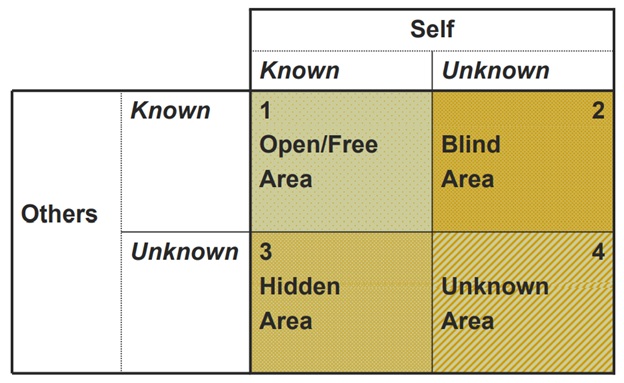JO-HARI Page
The Johari Window model
Lorem ipsum dolor sit amet nullam id egestas urna aliquam
- A simple and useful tool for understanding and training self-awareness, personal development, improving communications, interpersonal relationships, group dynamics, team development and intergroup relationships
- Developed by American psychologists Joseph Luft and Harry Ingham in the 1950's, calling it 'Johari' after combining their first names, Joe and Harry
The Model
Lorem ipsum dolor sit amet nullam id egestas urna aliquam
- Also referred to as a 'disclosure/feedback model of self-awareness’, and an 'information processing tool'
- Represents information - feelings, experience, views, attitudes, skills, intentions, motivation, etc - within or about a person - in relation to their team, from four perspectives
- Can also be used to represent the same information for a team in relation to other teams
Terminology
Refers to 'self' and 'others'
- 'Self' - oneself, i.e., the person subject to the Johari Window analysis
- 'Others' - other people in the team
The four Johari Window perspectives
- Called 'regions' or 'areas' or 'quadrants'.
- Each contains and represents the information - feelings, motivation, etc - in terms of whether the information is known or unknown by the person, and whether the information is known or unknown by others in the team.
- The four regions, areas, quadrants, or perspectives are as follows, showing the quadrant numbers and commonly used names
Johari window four regions
- Open area, open self, free area, free self, or 'the arena': what is known by the person about him/herself and is also known by others
- Blind area, blind self, or 'blind spot': what is unknown by the person about him/herself, but which others know
- Hidden area, hidden self, avoided area, avoided self or 'façade': what the person knows about him/herself that others do not know
- Unknown area or unknown self: what is unknown by the person about him/herself and is also unknown by others

The Johari Window 'panes'
- Show each quadrant the same size
- Can be changed in size to reflect the relevant proportions of each type of 'knowledge' of/about a particular person in a given team situation
- In new teams the open free space for any team member is small because shared awareness is relatively small
- As the team member becomes better established and known, so the size of the team member's open free area quadrant increases
The Four Quadrants
- Quadrant-1
-
- 'Open self/area', 'free area', 'public area', 'arena'
- Also known as the 'area of free activity'
- Information about the person - behavior, attitude, feelings, emotion, knowledge, experience, skills, views, etc - known by the person ('the self') and known by the team ('others').
- The aim in any team is to develop the 'open area' for every person, because when we work in this area with others we are at our most effective and productive, and the team is at its most productive too.
- The open free area, or 'the arena' - the space where good communications and cooperation occur, free from distractions, mistrust, confusion, conflict, and misunderstanding.
- Quadrant-2
-
- 'Blind self' or 'blind area' or 'blind spot': what is known about a person by others in the group, but is unknown by the person him/herself.
- Could also be referred to as ignorance about oneself, or issues in which one is deluded.
- Not an effective or productive space for individuals or groups.
- Also include issues that others are deliberately withholding from a person.
- The aim is to reduce this area by seeking or soliciting feedback from others and thereby to increase the open area, i.e., to increase self-awareness.
- Team members and managers take responsibility for reducing the blind area - in turn increasing the open area - by giving sensitive feedback and encouraging disclosure.
- Managers promote a climate of non-judgmental feedback, and group response to individual disclosure, and reduce fear.
- Quadrant-3
-
- 'Hidden self' or 'hidden area' or 'avoided self/area' or 'facade'
- What is known to us but kept hidden from, and therefore unknown, to others.
- Represents information, feelings, etc, anything that a person knows about him/self, but which is not revealed or is kept hidden from others.
- Also include sensitivities, fears, hidden agendas, manipulative intentions, secrets - anything that a person knows but does not reveal.
- Relevant hidden information and feelings, etc, should be moved into the open area through the process of 'self-disclosure' and 'exposure process' Organizational culture and working atmosphere have a major influence on team members' preparedness to disclose their hidden selves.
- The extent to which an individual discloses personal feelings and information, and the issues which are disclosed, and to whom, must always be at the individual's own discretion.
- Quadrant-4
-
- 'Unknown self', 'area of unknown activity', 'unknown area'
- Information, feelings, latent abilities, aptitudes, experiences etc, that are unknown to the person him/herself and unknown to others in the group.
- Can be prompted through self-discovery or observation by others, or through collective or mutual discovery.
- Counselling can also uncover unknown issues.
- Again, as with disclosure and soliciting feedback, the process of self-discovery is a sensitive one.
- Uncovering 'hidden talents' - that is unknown aptitudes and skills, not to be confused with developing the Johari 'hidden area' - is another aspect of developing the unknown area, and is not so sensitive as unknown feelings.
- Managers and leaders can create an environment that encourages self-discovery, and to promote the processes of self-discovery, constructive observation, and feedback among team members.
- The unknown area could also include repressed or subconscious feelings rooted in formative events and traumatic past experiences, which can stay unknown for a lifetime.
The complete Johari Window Model
